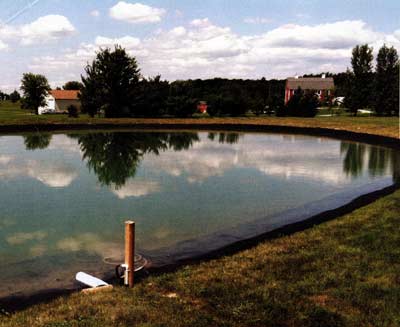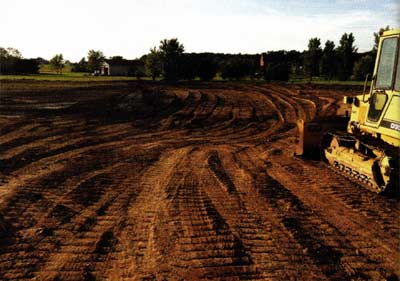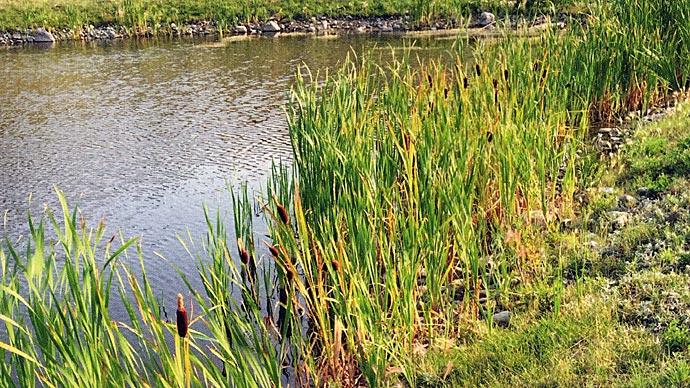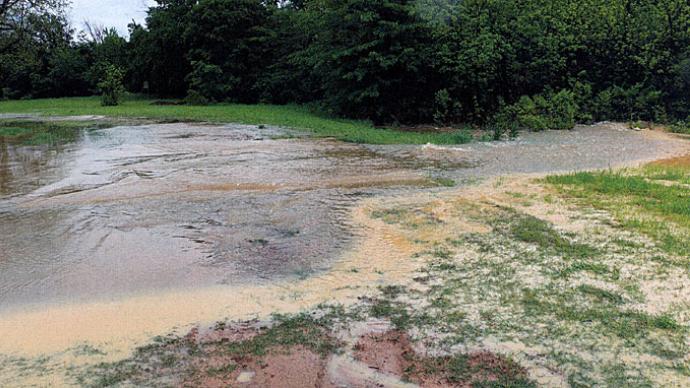
The "For Sale" sign had fallen over and was barely visible.
For some time, we'd been looking for a spot to build a home. My wife found three and a half acres advertised in our local Medina, Ohio newspaper. We set out to explore that opportunity and were soon disappointed to realize it was an over¬grown, weedy lot we had been driving by for months on our way to and from church. Since we'd made the trek there, I reluctantly decided to at least get out of the car and take a look around. Making my way through shoulder-high weeds and being scraped by briars, I stopped at the top of a hill. As I stood there gazing west, I could actually visualize our home on that very spot...overlooking our pond reflecting the sunlight.
Sometimes we just need to look beyond the weeds.
That was the fall of 2001, shortly after 9/11.
Fast-forward eight years; we purchased the land, our house was built on the hill, but our view to the west was still that tall weed patch.
Pond construction had fallen off our radar.
It was time.

I called a local excavator/pond builder to come out. I pointed to the site and explained where we wanted our pond. I don't think he was really looking for more work, but we hoped he'd help us figure it out. With a back- hoe, he dug a couple of test holes to see what kind of dirt we had. He said the soil was too sandy. Since he had constructed a nice pond for a friend of mine, I took him at his word and resigned myself to not having a pond... until the summer of 2012.
I'd thought about it often, and decided to give it one last try. I contacted our county soil and water conservation district office. A technician came out and said according to his soil maps, a pond might be a possibility. He handed me a list of potential contractors but was careful not to make a specific recom-mendation. I looked at the list and pointed to a familiar local company and when he nod¬ded, I felt I had made a good choice.
The company owner came out and I showed him where we wanted the pond. He was silent for a minute, pondering (so to speak) and then said he wouldn't build it there. He pointed to a more suitable location just to the northwest. His suggestion made sense to me so he and the county technician came out the following week and dug test holes that produced good clay. I checked out some of his other projects. References are a good thing. We then agreed on a price of just under $7,000 for a pond nine-feet deep and approximately a quarter acre.

That fall, construction began with the approval of our amazing neighbors. It was important to us to get their thoughts and let them know what we wanted to do. I took a day off to watch two seasoned heavy equip-ment artists with a combined ninety-years' experience operate bulldozers that pulled dirt pans through damp clay. It looked like they were cutting through peanut putter. They were finished in a week and I man¬aged to have grass seeded on disturbed soils before the weather turned cold.
Over the winter, I did more online re¬search and realized how much I didn't know about ponds. I did know we wanted riprap around the shore. By June, 2013 the pond was nearly full. I shot full pool elevations with a laser level, measured one foot further up the bank, and rented a bed edger to cut a small trench around the pond circumfer¬ence. I purchased a twelve and a half-foot roll of commercial geotextile fabric and had it cut into five-foot and seven-and-a-half- foot lengths. About half of the pond is a 3:1 slope. In those areas, my wife and I stapled the fabric down into the water five-feet from the trench. The other half of the pond has a slightly gentler slope, so we stapled fabric down seven and a half feet.
Thirty tons of #4 washed limestone (rocks about the size of an egg), a rented compact tractor with a bucket, and an old friend to run it, completed the job for less than $1,200. The water has never gotten to a level below the stone and the banks have remained intact.
That summer I added minnows and shiners and let them do their thing until I added largemouth bass, redear sunfish, and bluegills. The redears did not like my water chemistry and most of them expired—a mystery to me to this day. I had the same issue when I stocked hybrid stripers a few years later. Next, I tried yellow perch but think the bass probably ate them. Every summer, I add five pounds of tilapia. I'm not sure how much algae they eat, but they are fun to catch...and they grow quite large by the time they slow down and expire in the fall. This past November I added eight 10-12-inch rainbow trout to overwinter and provide some ice-out fishing in the spring.
They seem to be doing well.

I determined we needed aeration, so I researched windmills. I liked the rustic look but chose not to go that route. Our home septic system used a linear air pump so I purchased another pump just like it. Since the pond was only two-tenths-acre and nine feet deep, I felt my DIY system would be adequate. I have come to find, over the years, that it seems to do just fine. It is mainte¬nance-free, quiet, uses very little electricity and I can rebuild it for around $50.1 placed the pump in my basement and connected it to half-inch pex line buried in a trench two hundred feet to the pond edge. There, it attaches to a weighted airline that runs un¬derwater another ninety feet to an air stone in eight feet of water. That project was less than $1500. In the winter I disconnect the deep air stone and run one in about three feet of water. This keeps a hole in the ice that extends to the shoreline for safety and has, thus far, prevented a winter fish kill. I run an aerating fountain on a timer, mornings and evenings in the spring, summer and fall.
After the pond was full and riprap was in place, it dawned on me that a dock would be nice. That was something I hadn't thought through before construction. I decided to use aluminum frames with removable ce¬dar deck sections. I screwed two aluminum posts into the ground at the shoreline and then allowed the rest of the posts to sit on metal pads on the clay pond bottom. I have found that it is surprisingly sturdy. The deck height is adjustable and after eight years has required only minor adjustments. Last sum¬mer I attached a swim ladder for the kids.
I have no submerged rooted vegetation. Anything that pops up, I pull out. Some of you will disagree with that approach and I understand. Early on, because the young fish had limited hiding spots, our bass even¬tually overtook the baitfish and, after about seven years, I relocated over a dozen skinny 8-10-inch bass and restocked bluegills. I've added what I believe are now adequate artifi¬cial structures. Those, along with a rock reef in shallow water, afford small bluegills some level of protection. Structure placement would have been much easier and more effective before the pond was full. We don't know what we don't know and that's where I was at the time the pond was built. I feed the fish by hand almost every evening in warm weather. Even some of the bass have learned there is such a thing as a free lunch. I'm sure the tilapia like pellets better than algae!
Algae control and water clarity are a challenge. I use pond dye and am like a mad chemist, adding just enough to filter the sunlight but not enough that it looks unnatural. My wife can tell from my stained fingers when I've been in the lab. I no longer use copper-based algaecide. The advantage of a small pond is that I can physically remove most of the algae.
When a pond is dug, nature immediately begins to fill it back in. The more algae, tree leaves, and airborne particles I can remove physically, the better. I have found that a peroxide-based product works well to burn off residual algae on the rocks near the shore. By summer, as the water warms, algae become less of a problem—or maybe the tilapia are actually doing their job. I've tried adding beneficial bacteria and the jury is still out.
Our pond has largely replaced golf as my hobby since I retired just over two years ago. We love it when family is in town and kids are jumping off the dock, piloting the paddle- boat, or floating on inflatable unicorns and tigers. Our six-year-old great nephew has become an accomplished fisherman and I'm his worm man. I've taken up fly-fishing.
On summer evenings, it's relaxing to sit on the dock and listen to the splash of the fountain. We enjoy the views from our kitchen and great room windows. Our pond changes from day to day and season to sea¬son. Just when I think I've got it all figured out...I don't!
So much to learn. We are so glad we pushed past that falling "For Sale" sign, waded through the tall weeds and briars, and were able to turn our vision into reality.
Reprinted with permission from Pond Boss Magazine



